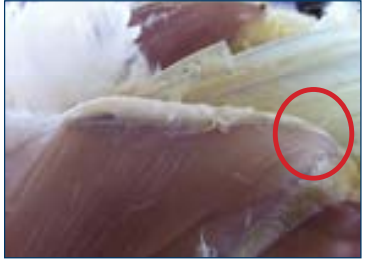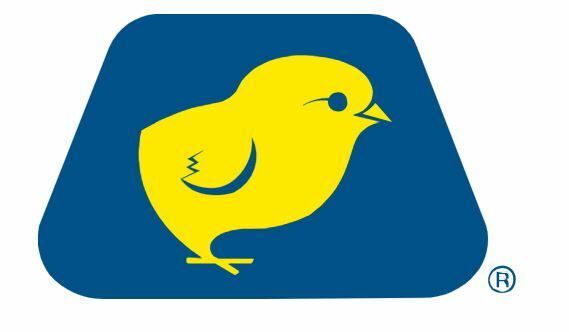



Soft-bone in cage and cage-free layers
Hy-Line Technical UpdateOsteomalacia in laying chickens is a common nutritional condition characterized by softening of the keel and leg bones, fatigue and/or depression, lameness, hair-line cracks or roughened shell surfaces on eggs that are laid, and, occasionally, decreases in production. Osteomalacia (literally “softened bones”) is colloquially called “Soft-Bone” and “Cage Layer Fatigue;” extreme forms of osteomalacia may be referred to as rickets. A mild form resulting in only egg shell abnormalities is often seen in older layers, and is colloquially known as “Soft-Shell.”
Pathogenesis of soft-bone
In the process of creating a shell around an egg, a chicken typically uses the available calcium in the bloodstream, then begins pulling calcium from her bones to finish creating the shell overnight. Large-particle calcium available in the digestive tract will continually be absorbed, minimizing how much calcium is needed to be pulled from bone deposits. During the day, calcium absorbed from the diet will replenish the blood and bone calcium stores and provide calcium for the next day’s egg. Phosphorus and vitamin D3 are necessary for the absorption and metabolism of calcium in the body. In the event that there are imbalances of calcium, phosphorus and vitamin D3 in the chicken’s body, more calcium may be pulled from stores in the bone than are replaced, and osteomalacia will occur. Inadequate intake or absorption of calcium, phosphorus or vitamin D, or excessive removal of calcium in relation to diet (such as during peak production) may lead to the physical symptoms of Soft-Bone.
Osteomalacia, or Soft-Bone, is a progressive disease; early detection through the handling of birds on a regular basis will ensure timely treatment and a high level of recovery in affected flocks. It is recommended that at least 100 birds per flock are handled when weighing birds to detect any abnormalities in the keel bones of birds.

Checking for soft-bone
While holding birds immobile with one hand, run the other hand down the length of the keel in a head-to-toe direction; feel for any flexibility in the straight edge of the keel. Feel the tip of the keel for straightness and solidity. Feel the ribs on the side of the bird for straightness and solidity.
Abnormal findings:
- Keel tip curves dramatically in toward the organs of the bird
- Broken keel tip
- Obvious flexibility along the length of the keel
- Sunken/collapsed ribs
- Beading along the ribs




Quantify the number of birds that showed symptoms of Soft-Bone. One in 50 showing symptoms is not unusual and may be explained by a bird that is not eating as well, is lower in the pecking order of the environment (cage or cage-free), or has an injury or other illness. If more then 3 in 50 birds are showing symptoms (>6%), intervention is recommended.
Note: Mortality will often show signs of Soft-Bone—birds that decrease intake due to illness or injury will also have decreased calcium, phosphorus and vitamin D3 intake, which is exacerbated if the bird continues trying to lay eggs.
Intervention methods for soft-bone
Intervention for Soft-Bone consists of supplementation of the diet with additional calcium, phosphorus and vitamin D3. Supplementation may be provided as a preventative measure in nonsymptomatic flocks, or as a treatment measure in symptomatic flocks. Preventative measures are especially recommended for flocks that are or are expected to reach high peak levels of production, or for flocks that consumption is low in relation to production levels the flock is achieving. Both preventative and treatment measures may be used in all strains and all housing systems; however, consultation with the assigned nutritionist is recommended to ensure that any supplementation is agreeable to the current dietary formulations.
Preventative supplementation:
- At 30–33 weeks, 50–53 weeks, 75–78 weeks of age:
- 15 kg/ton large particle limestone
- 5 kg/ton dicalcium phosphate (Di-Cal)
- 3 million units/ton of Vitamin D3
- This may be added as a top-dress or reformulated into the rations
- Each treatment will remain in the feed for 3 weeks at a time
Treatment supplementation:
- For symptomatic flocks, provide supplementation immediately
- For 1 to 3 weeks, provide:
- 15 kg/ton large particle limestone
- 5 kg/ton dicalcium phosphate (Di-Cal)
- 3 million units/ton of Vitamin D3
- Duration of treatment determined by severity of symptoms and response to treatment
- Mild cases may only need 1 week of supplementation; severe flocks may need up to 3 weeks of treatment
- This may be added as a top-dress or reformulated into the rations
25 Hydroxy D3 supplementation:
- Water supplementation can help improve calcium absorption and metabolism
- Use only when symptoms are present in a flock, and feed supplementation is not readily available
- Excessive use of 25 Hydroxy D3 may lower efficacy and response, and should be avoided; remove water supplementation once feed supplementation is available
- 25 Hydroxy D3 plus regular Vitamin D3 together should not be more than 4.5 million units/ton
Cautions when running supplementations for Soft-Bone
- Do not run supplementations continuously; birds will “reset normal” to the supplemented level
- Always consult with your nutritionist prior to making changes with feed rations










